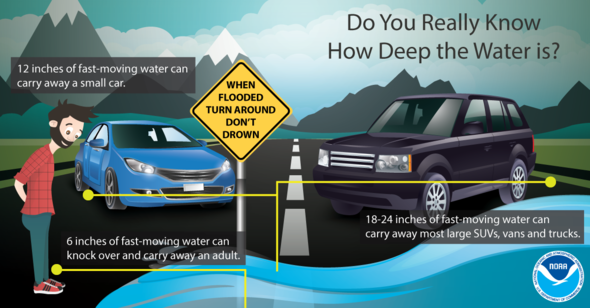The National Weather Service is forecasting an active spring weather pattern of rain showers and thunderstorms that will bring inches of accumulation to Indiana over the next several days. Persistent or heavy rainfall can saturate soils and cause waters to rise, and drivers should take precautions and be alert for hazards.
Keep storm drains clean
When stormwater drains are blocked, waters can rise rapidly and flood roadways. It is important that property owners keep drainage inlets near their property clean and clear of litter and debris to prevent blockages that can cause localized flooding.
Turn around, don’t drown!
Driving into flood waters is one of the most dangerous things drivers can do behind the wheel. Never drive through flooded roadways, especially if the water is moving rapidly, and never drive around barriers warning that the road is flooded.
When encountering a flooded roadway, death and vehicle damage can be prevented by following the simple advice to “Turn around, don’t drown!” According to the National Weather Service, more than half of all flood-related drownings occur when a vehicle is driven into hazardous flood water. Flash floods and floods are the number one cause of deaths associated with thunderstorms, with more than 90 fatalities each year.
The weight of a vehicle in high water will not always keep tires in contact with the road. The water is likely to be deeper than it appears, and it is possible that the roadway could be completely washed out. In addition, most cars can be swept away in less than two feet of moving water. Trucks and SUVs do not fare much better, even with additional clearance. Once a car is buoyant, the force of moving water can push vehicles sideways or upside down, giving passengers little time to escape.
Rules of the road for safe driving
Always turn on your vehicle’s headlights when windshield wipers are needed. If you need windshield wipers to help see the road and other vehicles, help other drivers see your vehicle by using headlights and tail lights. Likewise, always use turn signals when turning or changing lanes – especially when weather reduces visibility.
Prevent hydroplaning on wet roads by:
Properly inflating tires
Maintaining good tire tread
Reducing your speed
Avoiding puddles and standing water
Stopping and turning slowly
Driving in the tire tracks of the car in front of you
Turning off cruise control
When storms cause power outages, traffic signals are affected. Report power and signal outages and treat these intersections as all-way stops.
Know before you go
Pay attention to local weather forecasts before driving and avoid planning trips during inclement weather conditions, if possible. Plan your route and be aware of any weather-related hazards or closures on state roads and U.S. highways by using http://indot.carsprogram.org, 1-800-261-ROAD (7623) or 511 from a mobile phone.
INDOT’s regional Facebook and Twitter pages will have information posted about these incidents. INDOT’s social-media accounts can be found at http://bit.ly/INDOTsocial.
Subscribe to receive text and email alerts about INDOT projects and services at http://bit.ly/INDOTsubscription.
SOURCE: News release from Indiana Department of Transportation

